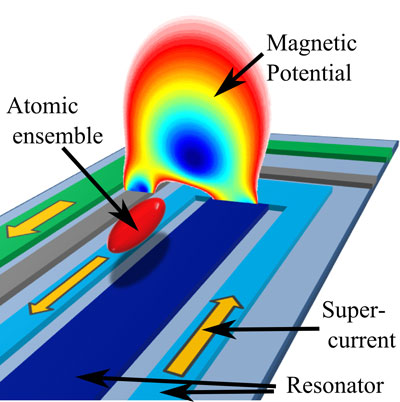| Aug 29, 2013 |
Physicists create interface between atoms and superconductors
|
|
(Nanowerk News) The coherence of quantum systems is the foundation upon which hardware for future information technologies is based. Quantum information is carried by units called quantum bits, or qubits. They can be used to secure electronic communications – and they enable very fast searches of databases. But qubits are also very unstable. Professors József Fortágh, Dieter Kölle and Reinhold Kleiner of Tübingen’s Institute of Physics have developed a new electronic component which will help to deal with this problem. The researchers’ long-term goal is to process, transfer and store superposition states such as the overlapping of the binary digits zero and one. The initial results of their work are to be published in the journal Nature Communications on 29 August 2013 ("Manipulation and coherence of ultra-cold atoms on a superconducting atom chip").
|
|
The researchers aim to link two systems and draw on the advantages of both. Superconducting circuits, which are structured on microchips using standard technology, can process quantum information quickly but cannot store it for very long. By contrast, atoms, nature’s smallest electric circuits, can serve as a natural quantum storage unit. “In the future, this combination will allow us to transfer information from superconducting circuits into ensembles of atoms and store it,” says Professor József Fortágh.
|
 |
| Quantum electronics with atoms and superconductors: Rubidium atoms are magnetically suspended above a superconducting microchip, creating a new interface between superconducting nanoelectronics and the atoms. This means the advantages of both systems may be harnessed to process, transfer and store quantum information. (Image: CQ Center for Collective Quantum Phenomena/University of Tübingen)
|
|
The atoms are trapped in a magnetic field above the surface of the microchip. Because superconductors allow an electric current to flow without resistance, the current does not become weaker in a superconducting ring. Institute of Physics PhD students Helge Hattermann and Daniel Bothner along with postdoctoral researcher Simon Bernon have made use of this to construct a complex superconducting ring-circuit and a particularly stable storage space for atoms. And the researchers can test how long atoms remain in the quantum superposition states within the system – by using the atoms themselves as a clock.
|
|
Today’s definition of a second is given to us by the caesium atom, with a frequency of approximately nine billion Hertz per second, corresponding to the transition between its two ground states. Rubidium, the atom used for the experiments in Tübingen, is a secondary frequency standard. An atomic clock’s precision is based on the constant transition between quantum states. Just like the swinging of the pendulum of a grandfather clock, an atomic clock’s oscillations become weaker with time – when the quantum superpositions decay.
|
|
The atomic clock integrated into the superconducting chip indicates that the atoms suspended above the chip remain in their quantum superposition states for several seconds. By comparison, solid-state quantum storage retains coherence for only microseconds. “This result paves the way for new quantum electronic components for information processing systems,” József Fortágh says. The researchers at the University of Tübingen’s CQ Center for Collective Quantum Phenomena are now planning experiments on atoms in superconducting microwave resonators – which could serve as a shuttle for data between integrated circuits and atoms.
|

